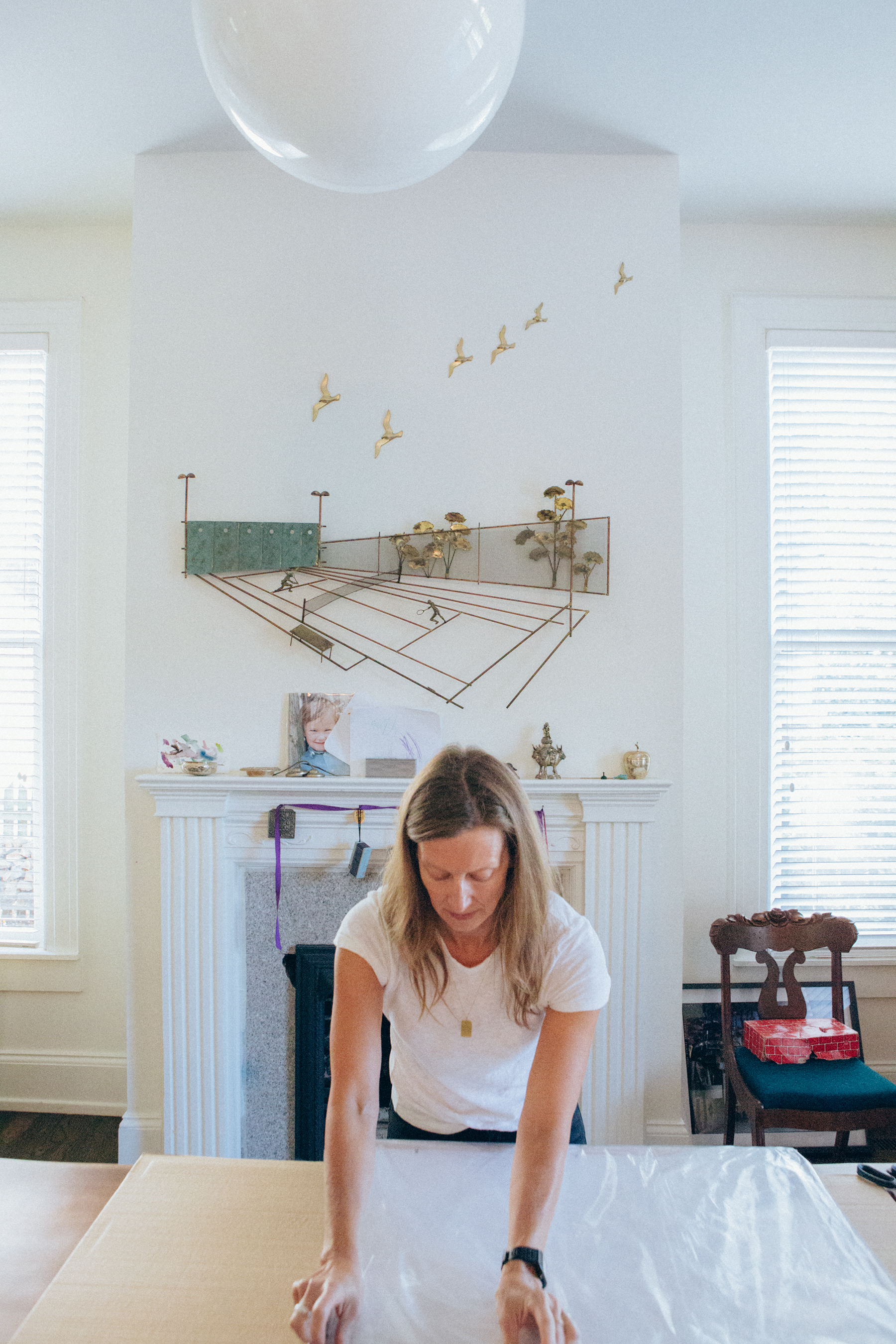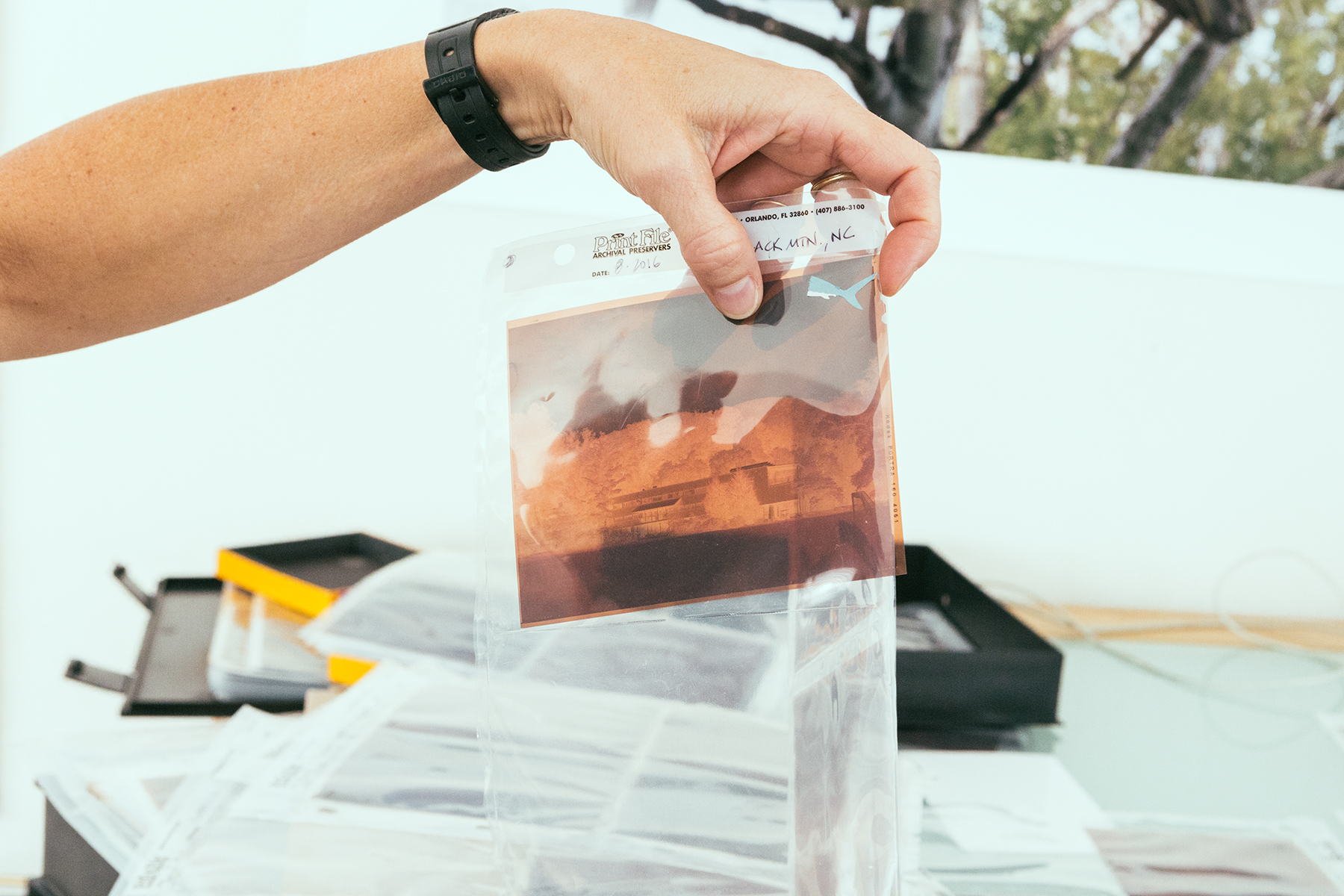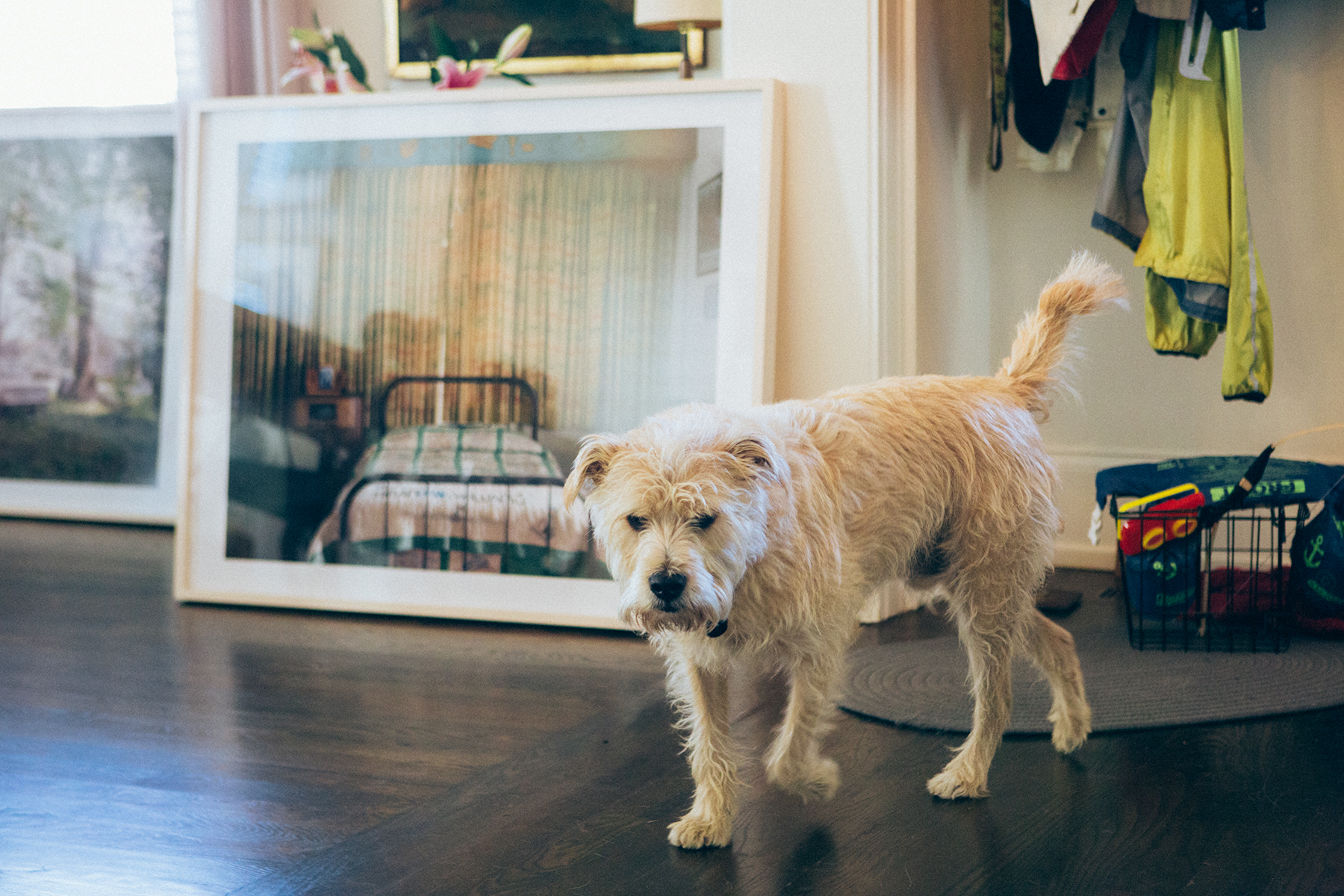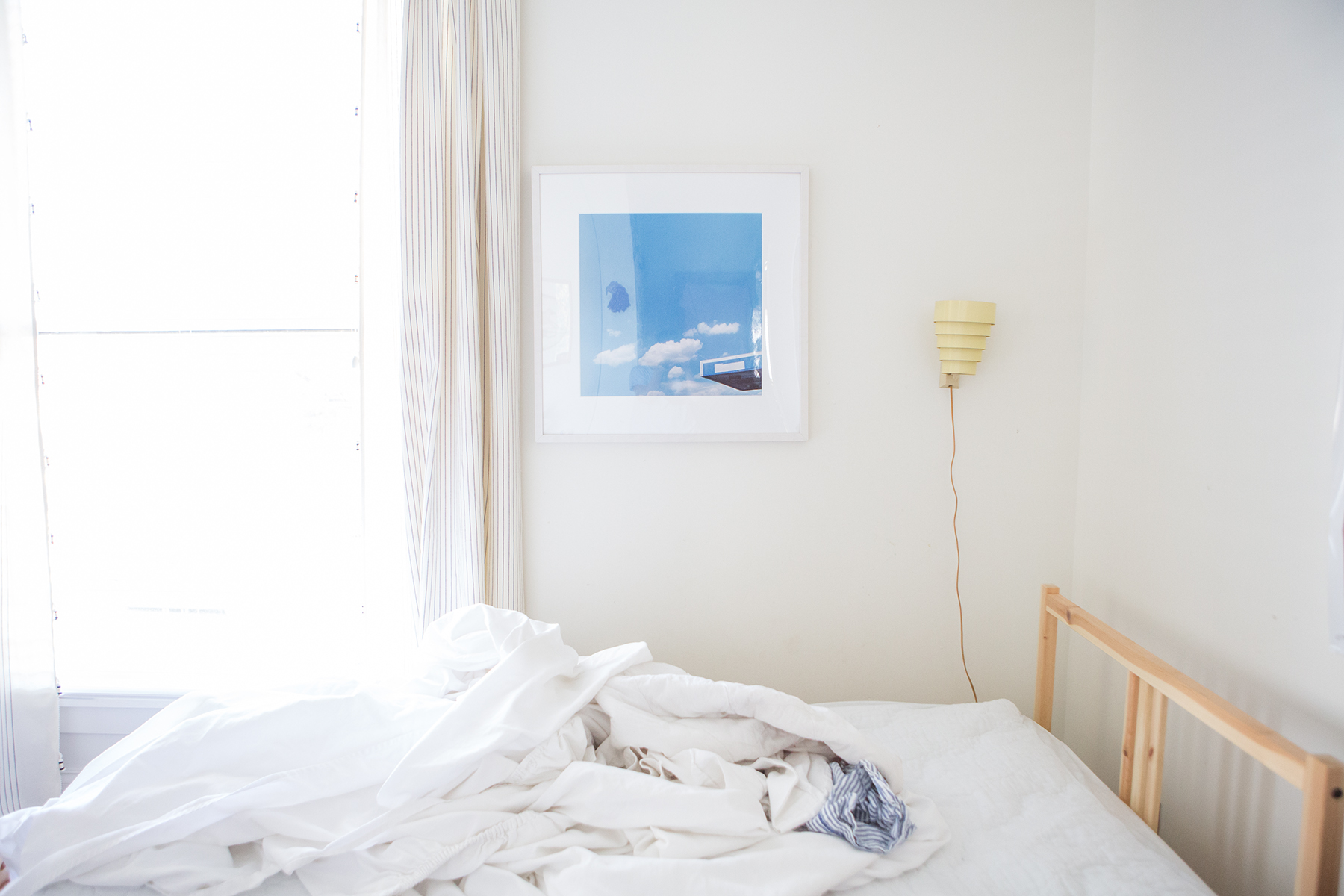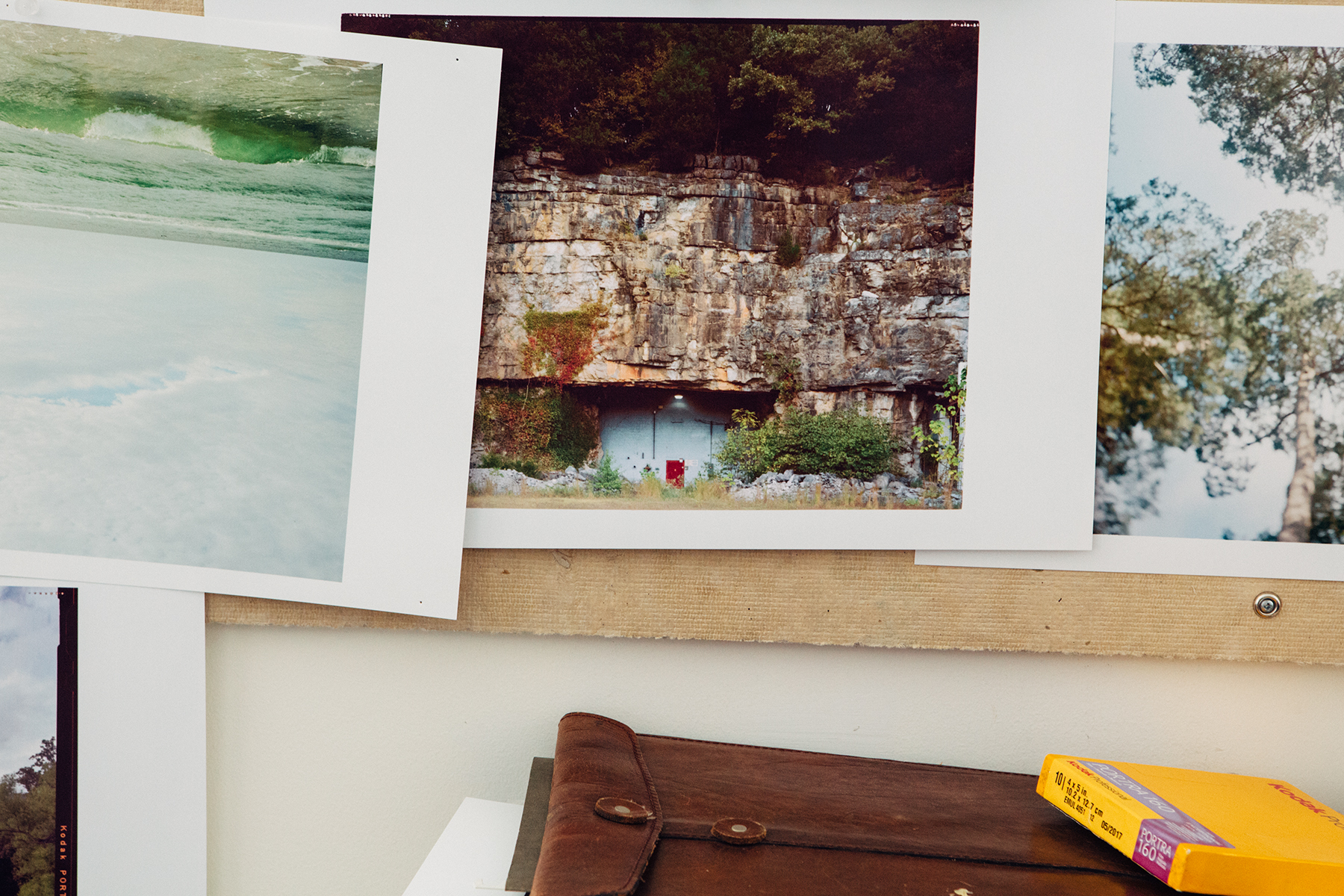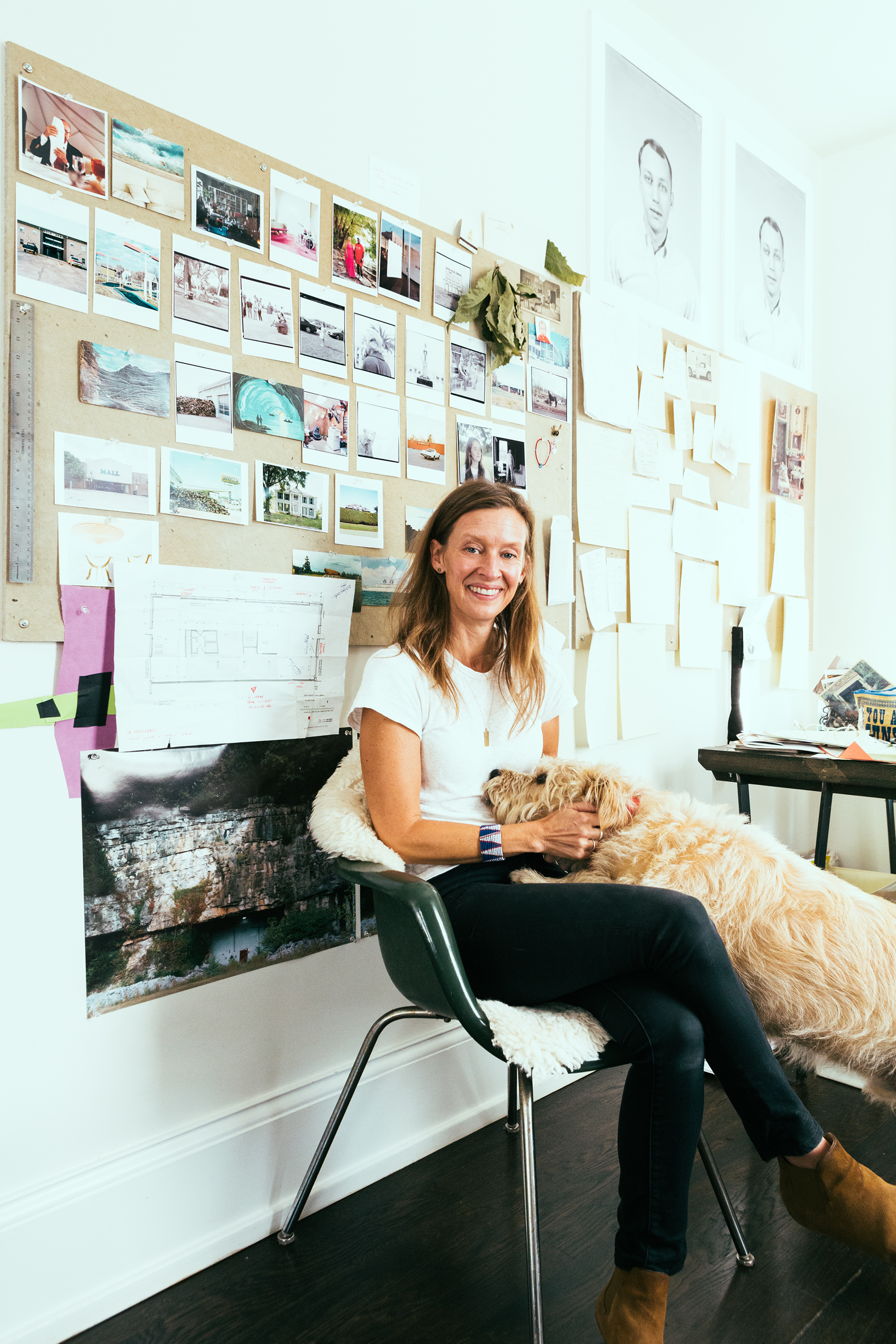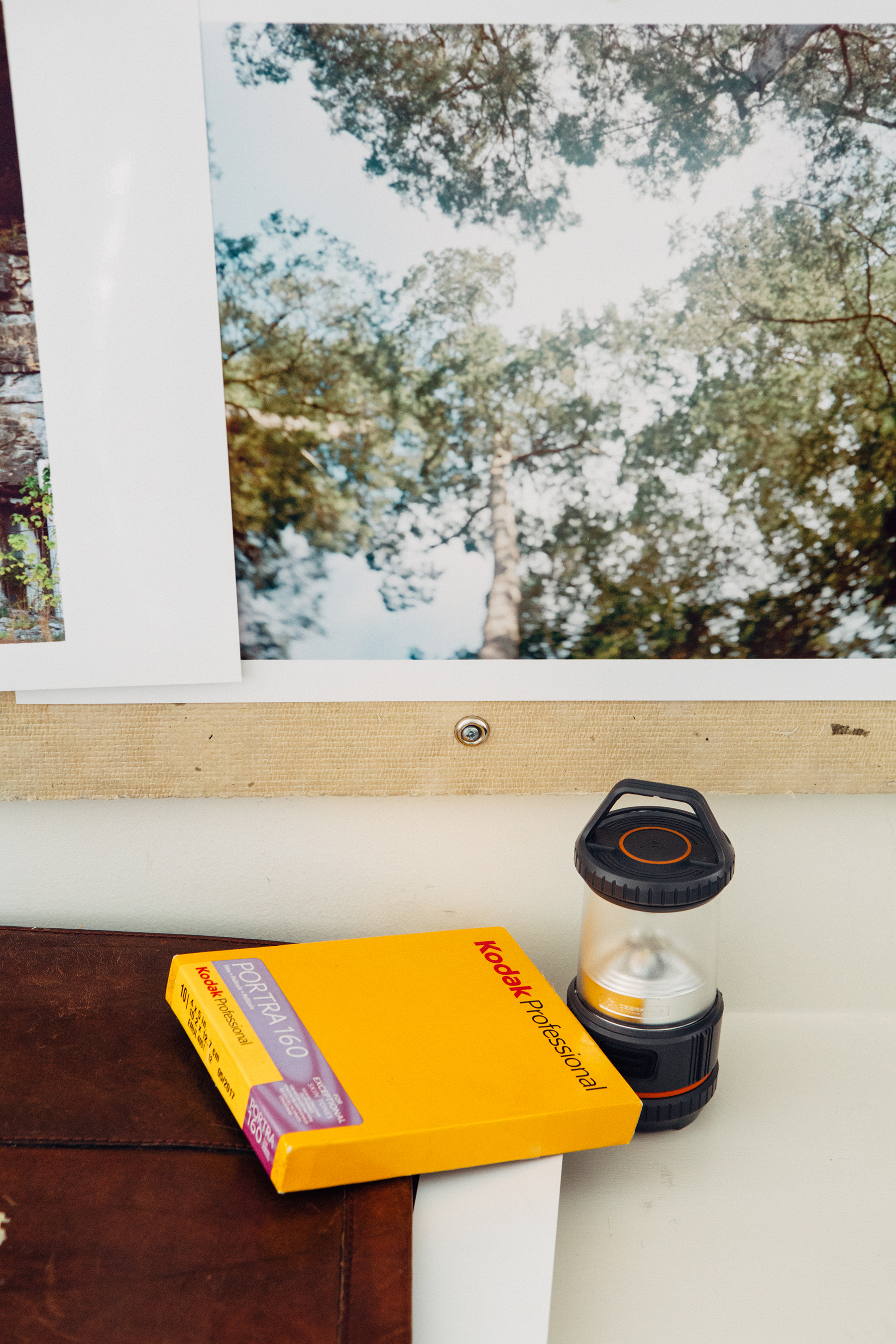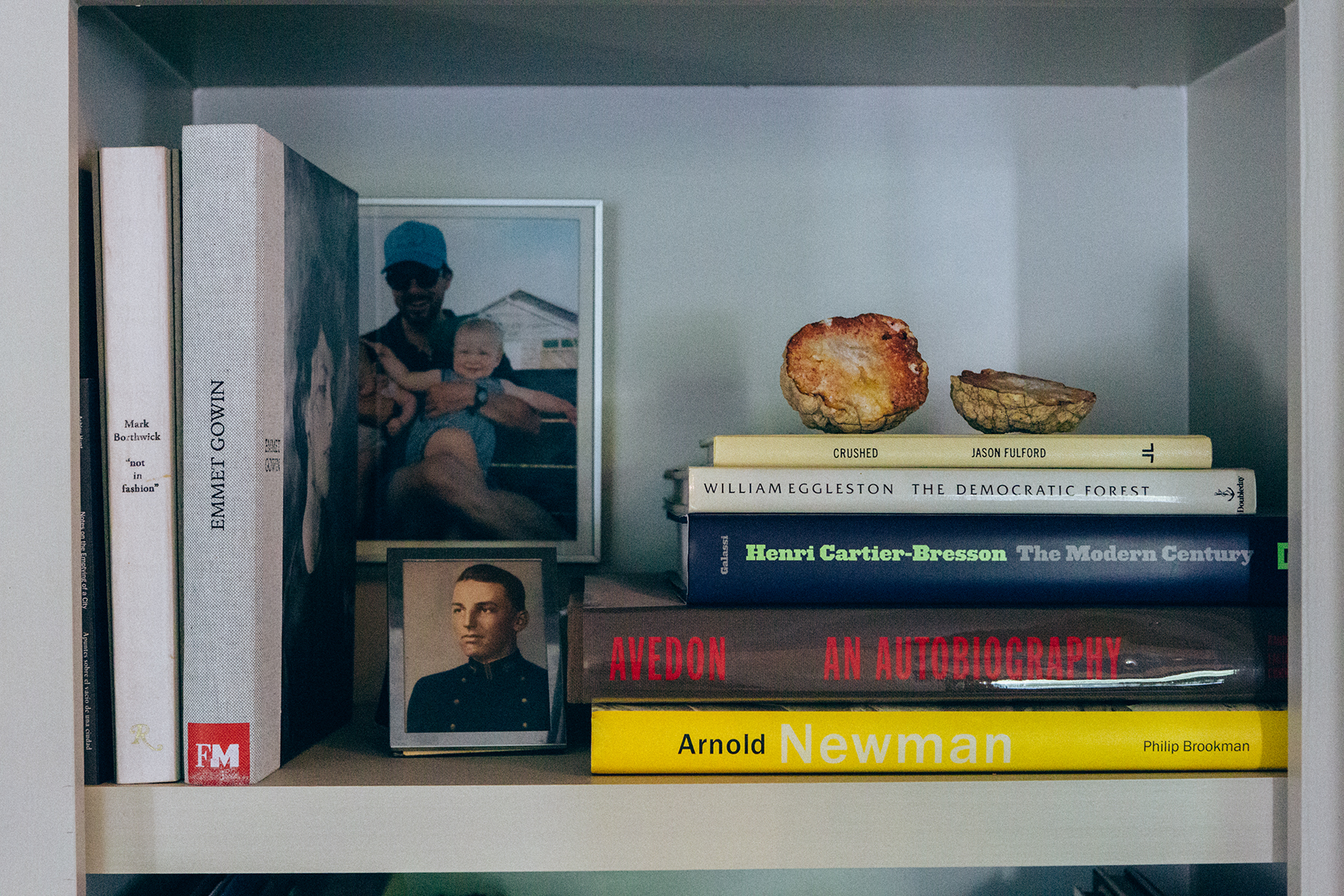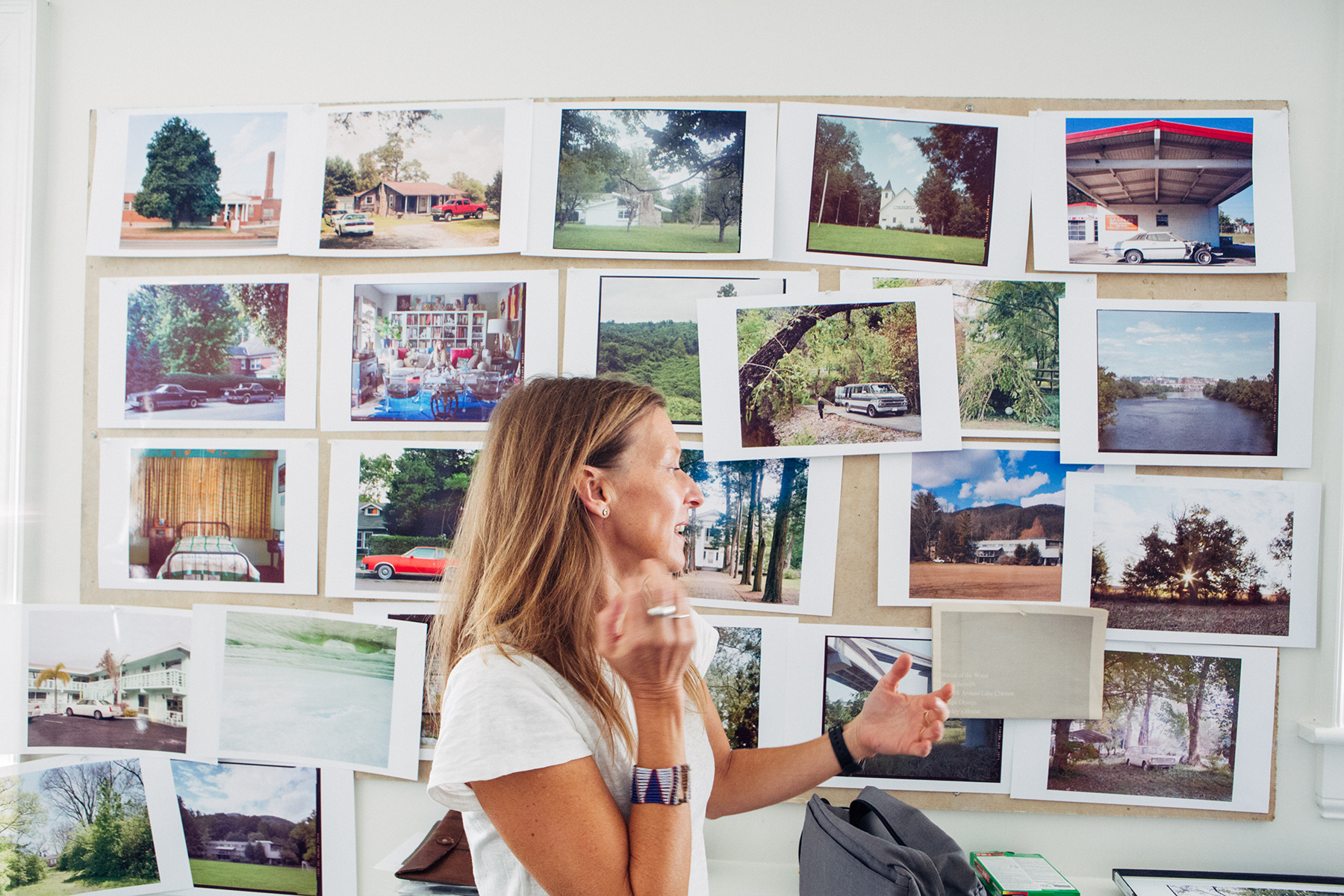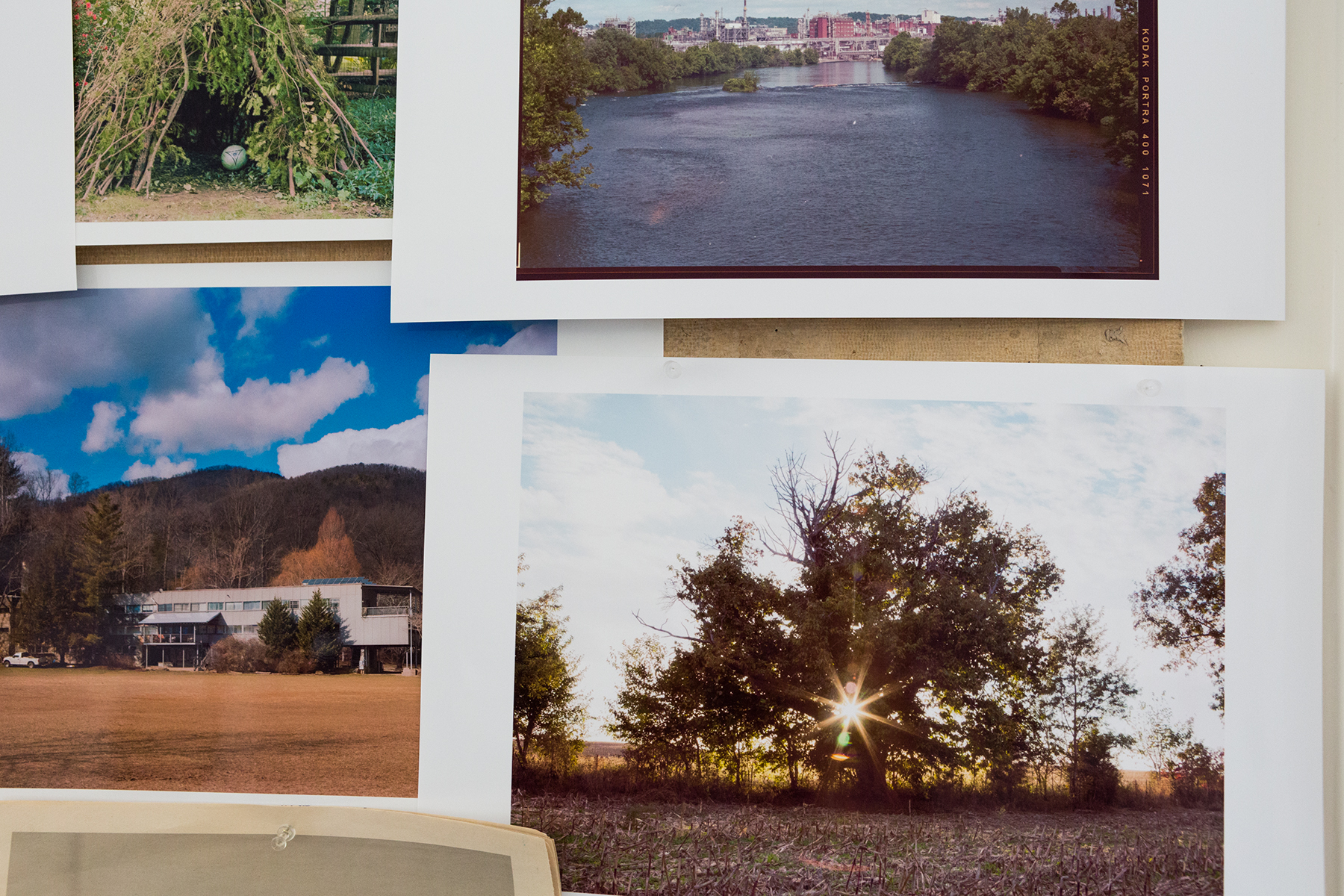Caroline Allison, Photographer
Photographer Caroline Allison at home in west Nashville, surrounded by work from Underground Again, her new show at Nashville's Zeitgeist gallery. All photos by Heidi Ross
Years before we became good friends, Caroline Allison and I were neighbors.
This was a decade ago, just two years after I moved to Nashville, when I was living in a darling 1940s triplex on the west side of town. To be totally honest, it wasn't a very high point in my life and, as I tend to do when my mind gets heavy, I was being a bit of a recluse. So when several of our mutual friends told me that I needed to meet the very lovely and creative fellow Southerner-by-way-of-NYC-er who had moved in two doors away from me on Leonard Avenue, I did nothing. (Depression is a crappy wingman.)
To say that I regret not expending the physical nano-effort to walk the half-block between our homes and knock on Lina’s door back in 2006 is a stunning understatement. The four years between then and our eventual meeting in 2010 would have no doubt been fuller with this smart, supportive and kind friend in my life.
Add talented to that list. Lina is an amazing photographer - and one that I am very honored to say shoots frequently for TCR.
A native of Atlanta, she studied at The University of the South, Sewanee and The School at the Art Institute of Chicago before hearing the siren call of New York in 1999. Since her move to Nashville in 2006, Lina’s been busy, shooting commercial and editorial gigs for shelter and lifestyle magazines and creating personal work for solo and group shows across the U.S.
In her personal work, Lina finds beauty and significance in familiar locations that others with less sensitive cultural antennas might overlook: the perfect-looking sitting room of Mason Lodge No. 135 in Greenwood, Mississippi; a stunning wide shot of the smoking TVA Kingston Fossil Plant, post ash spill; the thoughtfully needlepointed quilt on Hank Williams Sr.’s childhood bed. Vintage cars, living rooms and disused buildings are recurring motifs.
The simplicity and inescapable real-ness of Lina’s photography resonates with me deeply, and would regardless of our friendship. In fact, my first big art purchase was Twitty City, a Caroline Allison original that captures an extraordinary vignette at country star Conway Twitty’s estate, featuring, among other things, a gold Chippendale mirror behind a Liberace-ready white piano topped with Dottie Rambo sheet music and Christmas decor. It now hangs in my dining room, where I spend about 80% of my waking working hours. I look at it dozens of times a day; it makes me happy every time.
Lina’s latest creative endeavor debuts this weekend, at Zeitgeist, the Nashville gallery where she’s shown her work for over 15 years. Underground Again is a joint venture with her good friend and fellow artist, Patrick DeGuira. The show, which opens three days before the presidential election, explores ideas around history and the way it underscores what is happening around us now.
The conversation between Lina’s documentary style photographs and Patrick’s conceptually oriented works talks about time, failed ideas, and geology. Patrick’s contributions are multi-media, and include sculpture, sound, video, and installations. I got a sneak peek at Lina’s photos for the show a few weeks ago, when I stopped by the 12 South area home she shares with her architect husband, the extremely terrific Nick Dryden, and their two adorable kids, Emmett and Julia.
The Allison-Dryden household is a warm, comfortable and instantly familiar place. Like Lina, it’s elegant but casual. Downstairs, children’s toys line a long central hallway; to the right is an open kitchen – the undisputed heart of the home.
Upstairs, Lina’s studio is a long, light-filled space that runs the width of the house. Walls are pinned with prints of her recent work, including several pieces earmarked for the show: a photo of a gorgeously gnarled chestnut tree in Kentucky that is one of the few remaining specimens to survive the American blight of the early 20th century; the odd row of metal doors leading to a 14,000-square-foot underground warehouse built into a huge rock formation in Cumberland Furnace; the long Bauhaus-influenced main building at the former Black Mountain College in North Carolina, now a Christian boys camp.
Even though she was busy getting ready for the show, Lina hosted me with her usual warmth. After feeding me breakfast and making sure I was adequately caffeinated, we sat down in the kitchen for our chat, an edited version of which appears below. A few days later, our friend Heidi Ross – another camera-wielding TCR regular – no doubt got the same cozy treatment when she stopped by to take the photos that accompany the interview. Enjoy.
TCR: Your new show at Zeitgeist opens this weekend. How and when did you meet Patrick?
LINA: I don’t remember exactly when Patrick and I met, probably our paths crossed at some point through Fugitive Art, but we really got to be friends when we were both teaching at Watkins. I had always loved Patrick’s work and in a way, I first knew him through his paintings — super smart and with a serious dose of humor.
He has also shown at Zeitgeist for a long time, so we've always been in the same world. I think we probably formally met and started having conversations five years ago.
TCR: Is that when you joined Zeitgeist?
LINA: That's a good question! I don't really know. But I've shown work with Zeitgeist since about 2000.
TCR: So before you moved to Nashville?
LINA: Oh, yeah - in group shows. When I moved here in '06, that was the first time I had a solo show there.
TCR: So to back up a bit: You went to Sewanee, then grad school in Chicago.
LINA: I did, but I think in terms of when I started photography, that was high school. I had a great teacher, Miles Boyd, who was an artist. [LAUGHS] The truth of the matter is that the real hot elective to be in was chorale and I didn't make the cut! So I had to fill it with art class.
TCR: I'm so sorry. [LAUGHS]
LINA: We have some VHS tapes of me singing a duet of “Just You and I” from before I got kicked out. And it feels like a dog should start howling. It's so bad.
So essentially I started taking photography because I am tone deaf. No seriously, but when I think back to the impetus — and this is not unique to anyone who does photography — it gave me an excuse to be places that I don't think I would have felt comfortable enough or had the wherewithal at that age to go out and explore in the way that I did.
Then, on top of that, because my teacher was such a renegade, he would let me skip chapel. I didn't believe in God and I made a case to him that it was a real waste of my time to have to sit in chapel every week. [LAUGHS] So he would let me sneak into the darkroom. I’d double lock the door because we had a coach who would prowl the hallways to see that everybody was in chapel. So I would lock myself in there and have a complete hour to myself.
TCR: What were you shooting back then?
LINA: Oh my god. A lot of bad black and white. Cheesy stuff. Like, I would dress my sister up and put her in a bleak winter landscape.
TCR: I wonder how many bleak winter landscapes have been shot by young photographers over the years?
LINA: My sister in a white dress peering into a tunnel… I mean, deep, deep stuff. [LAUGHS] I look back now and it's interesting, I have binders of negatives that now span 26, 30 years of my life. This past winter I thought I was going to make a book — and maybe that's a project for a later time. But I was going back and looking at some of the negatives and was like, oh, okay, I see the beginnings of ideas and ways of seeing that have stayed with me.
But yeah, I started in high school. And I looked at Pratt and a bunch of other art schools for college, but I went to Sewanee... mostly because I thought it'd have cute boys. [BOTH LAUGH]
TCR: Let's be honest here!
LINA: I really thought I was going to be a Latin major. I was a big Latin geek in high school. And then I picked up photography again. After college, I took a few years off and then went to graduate school at The School of the Art Institute of Chicago. By that time, I'd figured out that's what I wanted to do.
TCR: So when did you form the style that you have today?
LINA: Probably the last year of graduate school, I figured out what my MO was. And then I started a project photographing interiors and that became something that segued into commercial and editorial work much later down the line, after I moved to Nashville. That was probably sometime in the late ’90s — this looking for spaces and sites and things like that.
TCR: Where do you think it came from?
LINA: Well, I've actually never thought of this until the other day. My mom was an interior designer and growing up, I spent a lot of time with her going to job sites, going to ADAC (Atlanta Decorative Arts Center).
TCR: Oh my god, I remember going to ADAC with my mother and aunt, too. I hated it!
LINA: You did? I loved it.
TCR: I guess I didn't appreciate it. Because today spending hours wandering around a building filled with home interior showrooms sounds like a dream.
LINA: I spent a fair amount of time in ADAC. You know, they had little cards and those tiny pencils you’d use to check things out — kind of like pre-IKEA. And my mom would tell me the numbers to write down on the ticket and I'd go give it to the lady in the window to get the sample.
So perhaps there's some of that early experience that plays into it. But the photographs that became defining for me were taken in my grandmother's house, which was decorated in probably 1968. My mom designed it. And it never really changed after that.
TCR: How would you describe it?
LINA: Oh my gosh, it was crazy. It was not as swinger-ish as Vadie’s house [LAUGHS], but we're talking wallpaper on the ceiling in the kitchen, and electric purple high-back chairs...
TCR: You’re killing me.
LINA: There was a turquoise couch, which is maybe the first photo that I made in color. It must have been an eight-foot-long couch. I remember my sister and I could lay toe-to-toe and not touch. But it was just this opulent silk turquoise couch under a really bad painting of a seascape with, like, a bad art light on it, you know?
TCR: I love that you could see the beauty in that.
LINA: And there was a lot of art from Mexico that they picked up when they would drive down there. My grandfather and his brother married my grandmother and her sister. The four of them would take my great uncle's limo.
TCR: Are you kidding?
LINA: They would drive to Mexico in Uncle Doc's limo. Potee and Doc would ride in the front and Ma and her sister would ride in the back, so the story goes. They drove from Glasgow, Kentucky, to Mexico every year. I mean, who does that? I would love to do that.
TCR: Me, too. That's incredible.
LINA: It was a great house. It was designed by Edwin Keeble.
So, I was interested in shooting these interiors. And it was a natural translation when I started doing commercial and editorial work. It was already what I was interested in. It was slightly different scope and I was shooting for somebody else, but I was still finding some maneuverability in there for me. Having to fulfill what somebody else wanted was kind of an interesting hat for me to put on.
TCR: Do you remember what you were trying to say by photographing your grandmother's place? Or was it just visually interesting to you?
LINA: I had a real specific thesis. It seems kind of hokey and too tight now, but I was looking for representations of idealized landscapes that you can find within a home. It was a good jumping off point for me. And those were the first color photos that I made; it’s when I made the jump. Because before that, I had only ever shot with black and white, I was shooting with these crazy 8x10 cameras. The negatives were enormous and I’d coat the paper with platinum. It was a pictorialist 19th century mode of image making.
TCR: Was there something about that kind of more involved process that you liked?
LINA: I think I've always liked the process. It’s different now. It used to be days and days in the darkroom and now it's all in front of the computer, except for when I take the photo. But then I do that with the old camera. You've seen it.
TCR: Yeah, I love it. It feels historical. And the fact that you have to be so still lends the process an air of importance.
LINA: It’s slow. I'm slow.
TCR: So you left Chicago and moved to New York.
LINA: When I graduated in '99, you either went to New York or you went to LA (if you wanted to be an artist). This was before people really took their heads out of the sand (about the potential of major art communities forming in other cities).
Anyway, I had always wanted to live in New York, so after graduation a bunch of us moved there en masse from Chicago. It was great. We were all scattered around Williamsburg and Greenpoint. We had shows together. We were all there together.
The great thing about our group was that everybody was really in it together. There wasn't a lot of elbowing. What was good for one was good for all. Like, we all worked at Bergdorf Goodman and did the windows together. One friend got a job in the visual department and then we all just wormed our way in.
TCR: I love your Bergdorf stories! Tell me another one.
LINA: One time, I remember being in the windows at 2:30 in the morning for probably the tenth night in a row during the run-up to Christmas. And that time of year, you knew that what was happening at Bergdorf was happening at Barneys was happening at... Everybody was burning the midnight oil, drinking coffee, taking smoke breaks.
One time, and I think I was with my friend Jean Loscalzo, we were in a window trying to place — oh, I don't know what it was. Snow. With glitter. We were trying to place this fake snow under all these dead birds that were suspended from the ceiling. There was a taxidermied snow rabbit and owls and doves and maybe even a fox? It truly was the Window of Death. [LAUGHS] And I remember David Hoey (senior director for visual presentation at Bergdorf Goodman) standing outside pointing to me, motioning for me to put a little more snow glitter over here, and then over there, these microscopic changes that could drive you to the edge of insanity, meanwhile he’s laughing a little because he knows you’re about to lose it… And I finally just turned around and double shot him the bird. “I am so tired. Get away. Leave me alone!”
TCR: “No more snow glitter!” [LAUGHS]
LINA: But the attention to detail was insane. There is this great guy that we worked with, Demetrious. He would make whole windows entirely from white paper. So there would be a poodle that was constructed out of white paper, with fringe for the eyelashes and everything. It was meticulous beyond meticulous.
TCR: That’s such a singular New York job, not to mention one that not very people get to experience.
LINA: I know. We would work this big run-up to Christmas and then you'd go and do something else for a while because they didn't need you. But it was great. Even when I was working my job-job with John Wigmore I still did it.
TCR: Who is John Wigmore?
LINA: John Wigmore makes these beautiful lights that are rice paper on steel frames. I starting working with him in his studio in Red Hook and later moved to Long Island City. We would make these lights that were just beautiful and glowy and then go install them in fabulous homes and restaurants.
To get back to why I moved to Nashville: part of the reason is because even though I was printing and showing work in New York, I was always shooting down here. Even when I was in graduate school I was shooting in the South. I used to feel like there was something wrong with me, like why can't I make photographs I like in these other places?
And so after years of therapy [LAUGHS], I came to the conclusion that maybe I should stop being so schizophrenic about this. Maybe I should move to where I make the photographs. And I was ready for a change.
TCR: I hear you. New York is an incredible place to live but it’s also a great place to leave.
LINA: It is. It is. My sister lived there while I did and she left to move to Charleston with her husband. And when I was contemplating a move, Libba said to me, "Don't do what you did in Chicago." And I said, "What are you talking about?" And she said, "Don't stay too long." I had never really thought that I had stayed too long in Chicago but clearly there was something going on with me that she recognized. And I thought, "Oh, okay. It's time." So I moved here. And I met Nick maybe a month later.
TCR: And you taught at Watkins?
LINA: Yeah, I did the adjunct shuffle for a while: I taught at Watkins, I taught at Nashville State, I taught at Sewanee. It was great. You know, the skills that I had leaving New York didn't necessarily translate — making $40,000 lights and doing window design. I mean, they could now, but in 2006 they didn’t. I had taught when I was in Chicago and loved it. So teaching was something I was really glad to return to.
TCR: Do you like teaching?
LINA: I love it. And I loved teaching at Watkins. Oh my God, I had some amazing students. I mean, really talented.
TCR: And of course, you continued to do your own work. How do you think your work has changed since you moved to Nashville?
LINA: That is a really good question. It was good for me to get out of New York. And it was good for me to not have so much conversation, you know?
TCR: About art?
LINA: Yeah. I think I needed to dig in. I found a process of making work that I really like. And that had kind of eluded me in other places. I started making photographs that involve historical research, extended conversations, relationship building, and mapping. Sometimes it takes a conversation over many months or even a year to gain access to some of these sites or to figure out how to best make the photograph.
I don't know that I could have figured that out without being here. I got to dive into myself a little bit and stop constantly looking at things from a third person perspective.
I felt the freedom to breathe here - and that happens on so many levels. Nashville feels supportive in many ways. There is an open-ness and kindness to new ideas and creativity that makes this a special place, and I’m grateful to be here and be a part of things.
Underground Again opens at Zeitgeist Gallery this Saturday, November 5 with a public reception from 6-9 pm. The show runs through December 17. Zeitgeist is located at 516 Hagan Street in Wedgewood-Houston.
Our multi-talented friend Heidi Ross is a whiz with words and visuals. An accomplished photographer, copywriter and graphic designer, she currently does creative direction and content creation for brands and artists. You’ve likely seen her photography on album covers, book jackets, or the walls at Third Man Records, which hosted her ILK: Similars 2004-2016 exhibit last summer. Follow Heidi on Instagram at @heidirossphoto to see more of her work - not to mention photos of her recent wedding!



